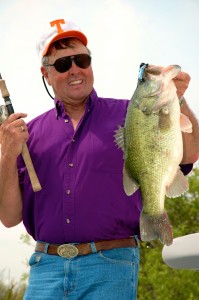A look at largemouth and smallmouths–from the start
Posted: November 5th, 2014 by Bill Dance
As many of you know, I live in a state that is blessed with excellent largemouth AND smallmouth fishing. Being from the same family, you gotta know they have some likes, yet the two also have their differences.
 Today, I’m going to explore this comparison from the beginning…literally…and compare the spawning habits of bronze backs and largemouths.
Today, I’m going to explore this comparison from the beginning…literally…and compare the spawning habits of bronze backs and largemouths.
Both the largemouth and smallmouth bass spawn in the spring as the water temperature move from cold to warm. Spawning is triggered by a number of factors and generally takes place when the water is somewhere between 60 and 70 degrees F. At that time, the male bass will move into the shallows and fashion a nest in the bottom. Smallmouths prefer a gravel bottom, while largemouths use either gravel or sand bottoms for nests.
Largemouths nest in about one to 3 feet of water within 10 feet of shore, and the nests are spaced at least 20 feet apart as a rule. Smallmouths seem to be more concerned with cover and will build a nest in water ranging from three to almost 25 feet in depth. The exact spot is determined by water clarity, and you can assume that the clearer the water, the deeper the nest.
Once the nest is built, the male bass will seek a mate, luring or driving the female over the nest. When she has dropped eggs in the nest, the male will broadcast his milt over the eggs to fertilize them. Each female is capable of producing 2,000-7,000 eggs per pound of body weight, but all the eggs are not spawned at one time. In fact, a male usually spawns with several females, and the same female could spawn with a number of males.
When it’s all over, there could be almost 2,000 eggs in a nest. The female then moves into deeper water and the male remains to guard the nest. It takes between a week and 10 days for the eggs to hatch under normal conditions, but exceptionally warm water temperatures will speed the process. The bass fry are hatched with a yolk sac attached under their gills; the yolk sac supplies food for the first days of life.
A male on guard duty over a nest is particularly aggressive and will strike at anything that comes close to his charges. Bass during this period are very easy to catch if you can find them on the nests, but it also begs the question of how the removal of the male guard (or the female that is about to spawn) will affect the bass population in that particular body of water.
Smallmouths leave the nest before largemouths do, and the tiny fry may be only 1/2-inch in length when they strike out on their own. Largemouths may be an inch long when they go it alone. In the process, however, one or both parents might turn on their offspring and attempt to consume them. At times, Papa Bass might devour 80 or even 90 percent of his brood.
Once the yolk sac is absorbed, the baby bass start to feed on live food and will move into the protective cover of the shallows. Until the bass are a couple of inches long, their main diet is composed of tiny crustaceans. Then they switch to smaller fish, crawfish and larger crustaceans.
As always, catch one for me!

